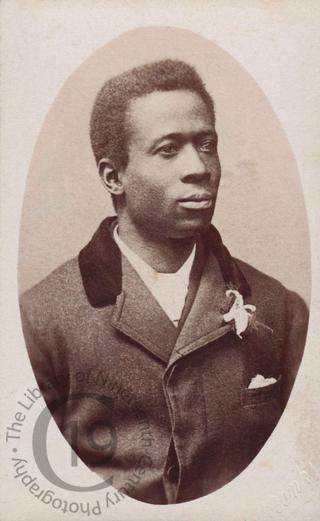
Celestine Edwards
A carte-de-visite portrait of the Methodist evangelist and journal editor Samuel Jules Celestine Edwards. According to his DNB entry, he ‘was not only Britain’s first black editor but also one of the first in Britain to link the anti-imperialist struggles of all colonized peoples. He was also a proto-Pan-Africanist who helped pave the way for […] the men and women who organized the first Pan-African conference in London in 1900.’
One of ten children, he was born on the island of Dominica, probably on 28 December 1857. His parents, descendants of slaves from Africa, were Catholics but Celestine was educated at a Wesleyan chapel school in Antigua. In 1870 he stowed away on a French vessel bound for Guadeloupe and spent the next few years travelling the world, working his passage aboard various ships. In 1870 he settled in Edinburgh, where he became involved in the temperance movement, joined the Primitive Methodist church and became an evangelist. He then lived briefly in Sunderland and Newcastle before settling in London.
He studied theology at King’s College and attended the London Hospital as a medical student. He wrote several religious pamphlets defending Christianity and attacking atheism; he also became an extraordinarily successful evangelist, first for the Methodist church then later for the Christian Evidence Society (CES). In 1891 he published a short biography of Walter Hawkins, a former slave who had become a bishop of the Methodist Episcopal Church in Canada. In 1892 he launched Lux, a Christian weekly which became a mouthpiece for his Christian socialist and anti-imperialist views. He also became the general secretary of the Society for the Recognition of the Brotherhood of Man and edited its monthly journal, Fraternity, quickly building its circulation to more than 7000.
In addition to his duties as editor, he continued to lecture for the CES to large crowds all over the country. In Bristol on 3 July 1893, he spoke on lynching in the United States. The following week he spoke to 1200 people in London on ‘American Atrocities’ and in August he was in Liverpool lecturing on 'Blacks and Whites in America.' Similar talks were given in Plymouth, Aberdeen, Newcastle, Edinburgh and Glasgow. Popular topics included 'The Negro Race and Social Darwinism' and 'Liquor Traffic to West Africa.'
At the time of the 1881 census he was a 'Lecturer' boarding at a house in Bury, Lancashire. He gave St John's in Antigua as his place of birth. At the time of the 1891 census he was living at 50 Tudor Road in Hackney with Mary Adams, his 60-year-old widowed housekeeper. He gave 'Medical student' as his profession and again gave St John's as his place of birth.
The pace, however, was gruelling and his health collapsed. A subscription was raised which enabled him to return to his family in the West Indies. He arrived at Bridgetown in Barbados on 1 June 1894 and died at the home of his brother on 25 July that same year.
Photographed by Robert Banks of Manchester.
Code: 126271




